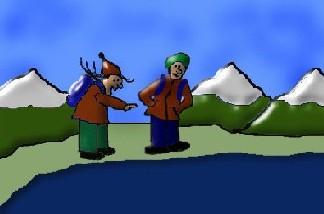What do you think they will find in the lake?
Click on image for full size
Windows to the Universe original image
The Search for Life on…Earth!
News story originally written on November 3, 2002
Scientists are studying what lives in lakes high in the Andes Mountains to learn how life may survive in other places in the solar system.
One of the lakes is on top of a volcano in Chile. Being so far up on a mountaintop would be a tough place to live! In fact, scientists think this place is very much like Mars because there is less oxygen, more sunlight and it is very cold.
Even though it is a harsh environment, tiny life forms survive there. The scientist team hopes to learn how they survive. The team will look at the life in the lake during their trip to the Andes Mountains this month.
If we know how these life forms survive harsh conditions on Earth we will understand the ways that life may have been able to exist on Mars, or Jupiter’s moon Europa, today or in the past.
Last modified October 23, 2002 by Lisa Gardiner.
You might also be interested in:

Europa was first discovered by Galileo in 1610, making it one of the Galilean Satellites. It is Jupiter's 4th largest moon, 670,900 km ( miles) from Jupiter. Europa's diameter is about half the distance
...more
It was another exciting and frustrating year for the space science program. It seemed that every step forward led to one backwards. Either way, NASA led the way to a great century of discovery. Unfortunately,
...more
The Space Shuttle Discovery lifted off from Kennedy Space Center on October 29th at 2:19 p.m. EST. The sky was clear and the weather was great. This was the America's 123rd manned space mission. A huge
...more
Scientists found a satellite orbiting the asteroid, Eugenia. This is the second one ever! A special telescope allows scientists to look through Earth's atmosphere. The first satellite found was Dactyl.
...more
The United States wants Russia to put the service module in orbit! The module is part of the International Space Station. It was supposed to be in space over 2 years ago. Russia just sent supplies to the
...more
A coronal mass ejection (CME) happened on the Sun last month. The material that was thrown out from this explosion passed the ACE spacecraft. ACE measured some exciting things as the CME material passed
...more
Trees and plants are a very important part of this Earth. Trees and plants are nature's air conditioning because they help keep our Earth cool. On a summer day, walking bare-foot on the sidewalk burns,
...more















